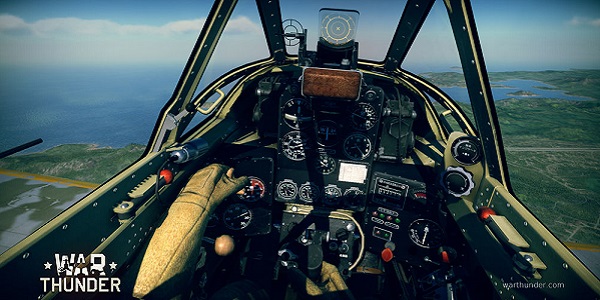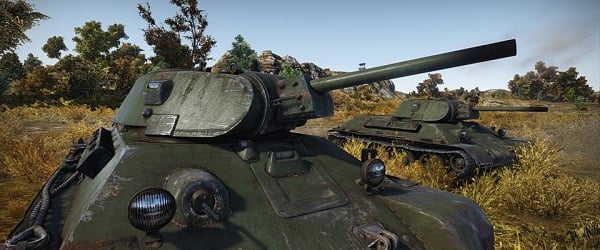E3 2014: War Thunder Soars With Oculus Rift

“I’m a believer.” Those are the first words I scribbled on my notepad after spending about 15 minutes with War Thunder on the Oculus Rift. Having already played this World War II-era plane and tank combat game on the PlayStation 4, I already knew I was a fan. But now that I’ve experienced aerial warfare with a virtual reality visor strapped to my head, it’s the only way I want to play these types of games moving forward.
Tucked away in the concourse meeting hall of the Los Angeles Convention Center during E3 2014, the folks at Gaijin Entertainment had a pair of rooms set up to show off their most recent developments for War Thunder. The game has been available on the PC for a couple of years now, but made the jump to the PlayStation 4 in Europe at the launch of the new console and only a couple of weeks ago here in North America. Originally focusing on fighting in the clear blue yonder, the tank update recently went live, bringing a new dimension of play to the combat. Eventually, the plan is to incorporate water-based warfare, too.
A free-to-play affair, War Thunder lets players immediately jump behind the controls of a nice collection of vehicles, with performance in missions and online battles unlocking new upgrades and, eventually, new crafts. You can purchase new skins for your crafts with real world money, as well as bypass a lot of the grind in order to speed up the unlocking process. There are also campaign packs that let you take on various historical battles. Otherwise, the game cost exactly zero dollars to get started, so you might want to give it a shot if your interest is piqued.
At Gaijin’s E3 booth, one of the rooms was filled with multiple devices, all running a tank combat match. The team was eager to demonstrate the cross-platform abilities of War Thunder, with a PC, a Mac and a PlayStation 4 all running their own versions of the game within the same server. I cruised around in a tank on a Mac while, right next to me, my teammates kept pace on completely different platforms.
It turns out I’m terrible with a tank, however, as I often found myself suffering from one-hit kills thanks to a well-placed round from an opponent, or I’d end up flanked and quickly overwhelmed due to not paying attention to my surroundings. The game ran smoothly, though, even though we were all in a full server and playing on different platforms.
In the next room, though, is where I think the real magic happened. I know that a lot of my colleagues have already had some hands-on time with the Oculus (some of them own headsets of their own, in fact), but this was my first experience popping on the headset.

Within seconds, my mind was already accepting the reality of the game world as legitimate. Everywhere I looked, I saw within the game in real time, the scenery moving around as smoothly as if I weren’t wearing the headgear at all. The game was, of course, set to first-person view, a gameplay mode I didn’t have a lot of luck with when playing on the PS4.
CINEMABLEND NEWSLETTER
Your Daily Blend of Entertainment News
With the Rift, though, everything seemed perfectly natural. With a throttle in one hand and a flight yoke in the other, I eased the plane forward and into the sky, delighted to see the in-game version of myself moving their hand exactly like I was in the real world.
My mission was simple: Destroy a slow-moving truck as it made its way down a country road. Instead of worrying about the enemy, though, I instead decided to focus on simply flying around, eager to just zip about, swoop down to the ground and sprint back up into the clouds. Looking around in real-time, I could see in every direction out of my plane’s windows, making the process of banking easier than ever as I would turn hard to the right and, looking through the “roof” of the plane, check out where I wanted to aim my craft once the turn was complete.
I was pretty bad at aiming in this mode, but that’s because everything was happening so accurately according to my real world movements. Every turn of my head or gentle nudge of the flight stick had its intended result, so I’m sure that more time in the cockpit would result in a steadier hand and, similarly, more accurate fire.
There was one point late in the game where I had accidentally pulled the yoke too close to the edge of the table it was resting on, and I could feel it start to lose balance and fall. I had been playing long enough at this point to sort of forget that I wasn’t staring at a screen. When I looked down at my right hand in the game world, it was like my brain couldn’t quite comprehend why it was seeing things normally, but feeling as though the piece of equipment was wobbling on the edge of the table. It was that convincing. Thankfully, one of the helpful folks at Gaijin caught wind of my predicament and helped me slide the controller back onto the table before I could cause any damage.
In short, War Thunder is better than it’s ever been with solid cross-platform play and more content coming out on a regular basis, and that’s only enhanced by some rock-solid Oculus support. My only hope is that the Gaijin folks weren’t taking pictures of me while I played, as I’m sure I looked like a slack-jawed hillbilly making his way into the big city for the first time.
As a final note for PlayStation 4 gamers, when asked if VR support was coming to Sony’s home console via the Morpheus headset, my only answer was “we cannot comment on Morpheus support at this time.” Consider my fingers firmly crossed.
Staff Writer for CinemaBlend.
Simu Liu Showed Up At The First Thunderbolts* Premiere After Revealing He Is Already Getting Those Avengers: Doomsday Abs Ready
Kanye West Just Hired A 'Hooligan Choir' Who Looks Like P. Diddy And Who 'Must Be Comfortable Wearing Swastikas'
I've Been To the Weirdest Attraction In Las Vegas, And It's A Grocery Store










